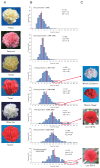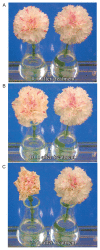Breeding of carnations (Dianthus caryophyllus L.) for long vase life
- PMID: 29681743
- PMCID: PMC5903979
- DOI: 10.1270/jsbbs.17091
Breeding of carnations (Dianthus caryophyllus L.) for long vase life
Abstract
Carnation (Dianthus caryophyllus L.) is one of the main floricultural crops in Japan and worldwide. The vase life of cut ornamental flowers, including carnations, is important in determining their quality and consumers' preference. To improve the vase life of carnation flowers, my group started a breeding research program in 1992 using conventional cross-breeding techniques. We repeatedly crossed and selected promising offspring with long vase life for seven generations, from 1992 to 2008. In 2005, we developed two cultivars, 'Miracle Rouge' and 'Miracle Symphony', with genetically determined long vase lives of 17.7 to 20.7 days (3.2 to 3.6 times that of 'White Sim') under standard conditions (23°C, 70% RH, 12-h photoperiod). Line 532-6 showed an ultra-long vase life averaging 27.8 to 32.7 days (4.6 to 5.4 times that of 'White Sim'). We evaluated changes in ethylene sensitivity with flower senescence simply and accurately using a time-lapse video recorder. In 2010, we selected line 806-46b with both ultra-long vase life (27.1 days, 4.4 times that of 'White Sim') and ethylene resistance. Analyses using six cultivars and 123 selected lines from the 1st to the 7th generations revealed that the long vase life was strongly associated with a decrease in ethylene production.
Keywords: carnation; ethylene production; ethylene sensitivity; flower longevity; flower senescence.
Figures









Similar articles
-
[Integration of different T-DNA structures of ACC oxidase gene into carnation genome extended cut flower vase-life differently].Sheng Wu Gong Cheng Xue Bao. 2004 Sep;20(5):704-7. Sheng Wu Gong Cheng Xue Bao. 2004. PMID: 15973994 Chinese.
-
Characterization of the role of sodium nitroprusside (SNP) involved in long vase life of different carnation cultivars.BMC Plant Biol. 2017 Sep 6;17(1):149. doi: 10.1186/s12870-017-1097-0. BMC Plant Biol. 2017. PMID: 28874121 Free PMC article.
-
Blue light postpones senescence of carnation flowers through regulation of ethylene and abscisic acid pathway-related genes.Plant Physiol Biochem. 2020 Jun;151:103-112. doi: 10.1016/j.plaphy.2020.03.018. Epub 2020 Mar 18. Plant Physiol Biochem. 2020. PMID: 32208322
-
Cryopreservation of carnation (Dianthus caryophyllus L.) and other Dianthus species.Planta. 2020 Nov 16;252(6):105. doi: 10.1007/s00425-020-03510-2. Planta. 2020. PMID: 33200329 Review.
-
Effect of preharvest conditions on cut-flower quality.Front Plant Sci. 2023 Nov 10;14:1281456. doi: 10.3389/fpls.2023.1281456. eCollection 2023. Front Plant Sci. 2023. PMID: 38023857 Free PMC article. Review.
Cited by
-
Genome-Wide Identification of the MYB and bHLH Families in Carnations and Expression Analysis at Different Floral Development Stages.Int J Mol Sci. 2023 May 30;24(11):9499. doi: 10.3390/ijms24119499. Int J Mol Sci. 2023. PMID: 37298450 Free PMC article.
-
Integration of Phenotype and Hormone Data during Adventitious Rooting in Carnation (Dianthus caryophyllus L.) Stem Cuttings.Plants (Basel). 2019 Jul 15;8(7):226. doi: 10.3390/plants8070226. Plants (Basel). 2019. PMID: 31311180 Free PMC article.
References
-
- Baker, J.E., Wang, C.Y., Lieberman, M. and Hardenburg, R.E. (1977) Delay of senescence in carnations by rhizobitoxine analogue and sodium benzoate. HortScience 12: 38–39.
-
- Boxriker, M., Boehm, R., Möhring, J. and Piepho, H.P. (2017) Benefit of statistical designs in two-phase experiments on vase life in carnations (Dianthus caryophyllus L.). Postharvest Biol. Technol. 128: 161–168.
-
- Burchi, G., Bianchini, C., Mercuri, A., Foglia, G., Rosellini, D. and Schiva, T. (1999) Analysis of post-harvest flower life in a cross between carnation cultivars with different ethylene responses. J. Genet. Breed. 53: 301–306.
-
- Carvalho, D.R.A., Koning-Boucoiran, C.F.S., Fanourakis, D., Vasconcelos, M.W., Carvalho, S.M.P., Heuvelink, E., Krens, F.A. and Maliepaard, C. (2015) QTL analysis for stomatal functioning in tetraploid Rosa × hybrida grown at high relative air humidity and its implications on postharvest longevity. Mol. Breed. 35: 172.
-
- Chandler, S. (2007) Practical lessons in the commercialization of genetically modified plants—long vase-life carnation. Acta Hortic. 764: 71–81.
Publication types
LinkOut - more resources
Full Text Sources
Other Literature Sources
